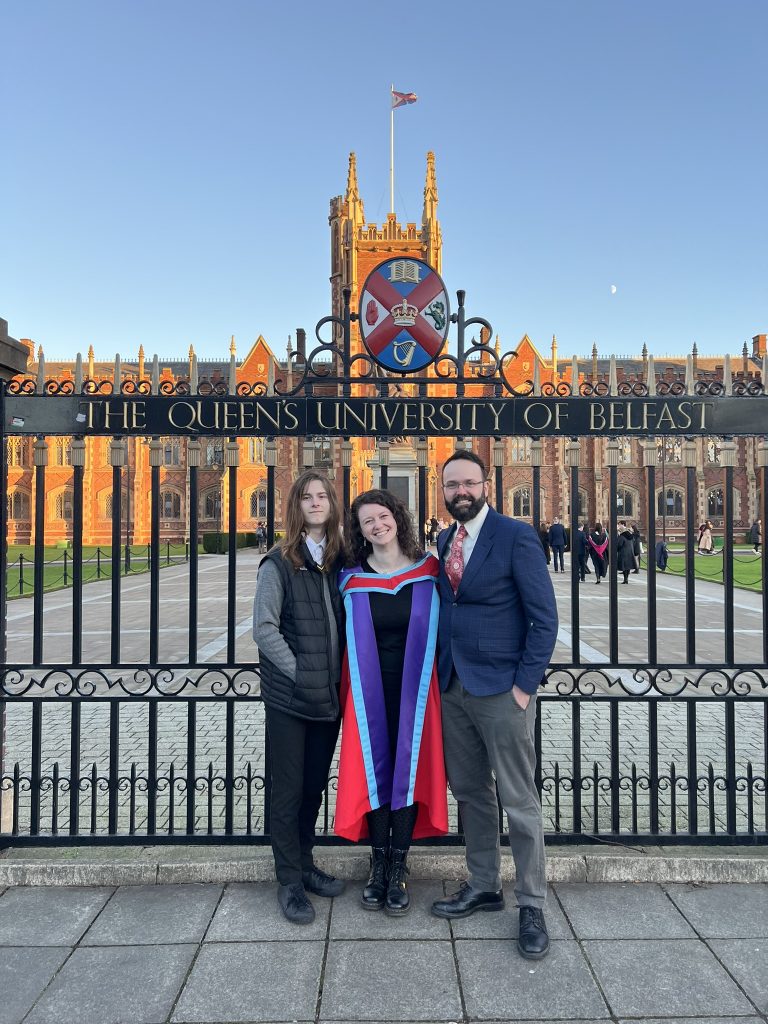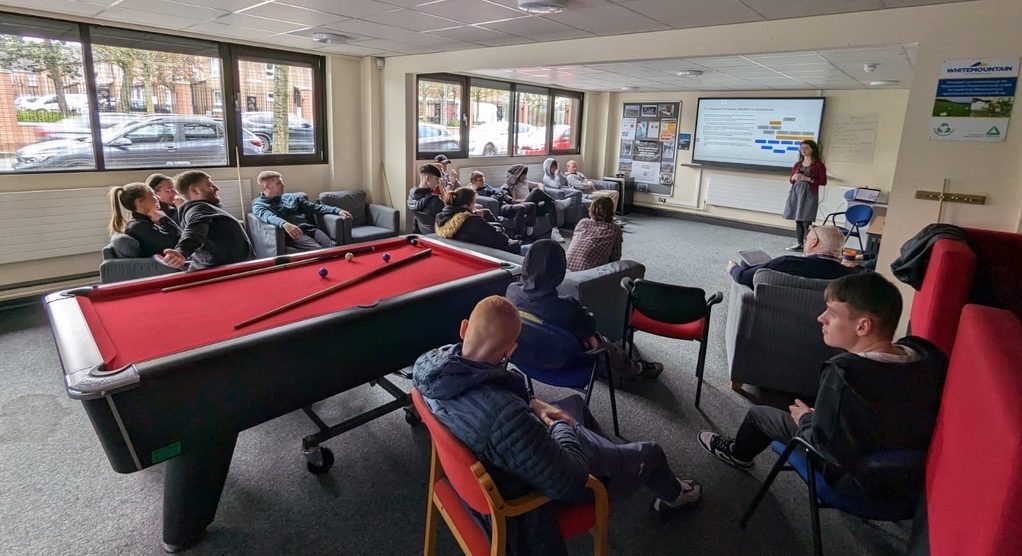Amanda Dylina Morse, PhD and Community-Oriented Public Health Practice (COPHP) MPH alum explores the link between masculinity and suicidality among young men in Northern Ireland. Her research, including the development of the Andrizo Integrated Conceptual Framework, provides valuable insights on how societal pressures around masculinity impact youth behavior and well-being.

Raised by her Irish maternal grandparents, Amanda Dylina Morse always knew she would eventually settle down in Northern Ireland. So, when the opportunity arose to pause her career and pursue her PhD at the Queen’s University of Belfast, she took it. “I had built this really specific skill set in public health focused on violence and injury prevention related to suicide. I knew there was a really high need for this type of work in Northern Ireland, so I went for it,” she said.
Since the end of the Troubles in 1998, Northern Ireland has experienced an epidemic of suicide, particularly among men and boys. Though rates have improved in recent years, they are still concerning.The Troubles were a period from the late 1960s to the 1998 Good Friday Agreement where Northern Ireland experienced violent conflict between the Protestant Unionists and the Catholic Nationalists, which began as a civil rights movement advocating for equal rights for Catholics. The conflict resulted in over 3,500 deaths and left deep political and social scars in the region, which are still felt today.
Although raised in the United States, Dylina Morse was always aware of the violence affecting her family. “The conflict in Northern Ireland was never a religious conflict; it was about ethno-nationalism, about whether continued occupation is in the best interest of the region,” said Dylina Morse. “The most socially disadvantaged communities continue to be the most segregated. There’s a lot of trauma in families and communities from the Troubles, and there’s continued socioeconomic disadvantage imposed on the region, which limits access to services and makes life more challenging for people.”
From the Troubles to Today
Dylina Morse’s previous experiences as a state epidemiologist studying overdoses and non-fatal suicide outcomes combined with her COPHP experience, gave her a unique skill set to study these trends for her PhD. “COPHP taught me the skills I needed to work with communities in just and equitable ways,” said Morse. “It was part of the reason I knew I wanted my PhD project to be strength-based. The suicide data for Northern Ireland has been counted and described extensively. We knew what was going wrong in communities, so I wanted to tease out what was right in communities that could help young men.”

Partnering with three youth work organizations, Dylina Morse recruited an almost even number of working-class Nationalist (Catholic) and Unionist (Protestant) 16-19-year-old boys for interviews. Findings from the interviews showed young men experienced an insistent pressure to demonstrate adult masculinity and they were strongly connected to their communities. The interviews also identified youth centers as essential safe places and commonly credited their youth workers (community members who support young people at youth clubs and after-school programs) for helping them feel more confident to make safer and healthier choices.
The Andrizo Integrated Conceptual Framework
Perhaps the most unexpected piece of Dylina Morse’s project was her creation of the “Andrizo Integrated Conceptual Framework,” which shows how the features of High Traditional Masculinity (the dominant form of masculinity in the US and Northern Ireland) can contribute to components of suicidal behaviours. The features of this masculinity: physical strength, courage, self-reliance, emotional concealment, and lack of emotional literacy were once essential traits for survival during the Troubles.
“It is tragically common for boys from different neighbourhoods and sects to fight each other. The features of physical strength and courage in High Traditional Masculinity lead to a heightened tolerance for pain, a lower fear of death, and a greater habituation to self-harm,” said Dylina Morse. “Similarly, self-reliance, emotional concealment and a lack of emotional literacy can lead young men to perceive themselves as a burden on their communities and also disconnect from them, which increases risk for suicide.”
The core component of the framework shows how youths’ willingness to act interacts with both masculinity and suicidal behaviours. “Youth don’t always intend to drink too much or throw bricks, or have unsafe sex, but they may be willing under the right set of social circumstances,” said Dylina Morse. “Young men exist in this unique space where their masculinity requires external validation and demonstration. They want to be perceived as exhibiting these adult masculinities, so they are willing to participate in these types of behaviours which put them at higher risk for suicide.”

When sharing back her findings with the young men and their youth workers, Dylina Morse made the decision to share the framework as well. “I anticipated we’d blow by the slide to get to the interview quotes, but immediately the lads and youth workers wanted to hear more about it,” said Dylina Morse. “I didn’t even get all the way through explaining it before the youth workers were turning to the young men and walking them through different examples using the framework. The lads lit up and were saying things like, ‘Oh, that’s class. I never thought of it that way before, but I do that!’ It was really gratifying to have both the lads, and the youth workers see themselves and their behaviours reflected in the framework.”
From research to action
The positive reception from youth and youth workers has encouraged various youth organizations to use Dylina Morse’s framework. One group is hoping to create a youth-friendly version of the framework to help youth understand their behaviours, and another is interested in using the framework to pilot better designed interventions. Dylina Morse will also be hosting a symposium with YouthAction North Ireland this summer to present her framework. The event, called “Shoulder-to-Shoulder,” will bring youth workers together to discuss support for young men and to drive new practices that could be implemented in the region. “The framework allows you to think about the upstream piece,” said Dylina Morse. “If substance use, fighting, or consent are the problems you want to solve, there are antecedents to those behaviours which need to be addressed first. You can talk to youth about intent all day, but if you never talk to them about their willingness to engage in those behaviours in the heat of the moment, or when they think the behaviour is expected of them, you’ll never actually get at the root of the problem.”
The struggle to find a healthy form of masculinity is ongoing, with alarming rates of violence, suicide and mental health struggles among young men. This epidemic is reflected in the troubling influence of figures like Andrew Tate and the exploration of masculinity in media, such as Netflix’s new hit series Adolescence. Dylina Morse’s framework offers hope by shedding light on the root causes of these behaviours. By examining the way masculinity functions, and the pressures young men face to embody it, Dylina Morse’s work provides valuable insights into how we can understand and address the issues young men face today.